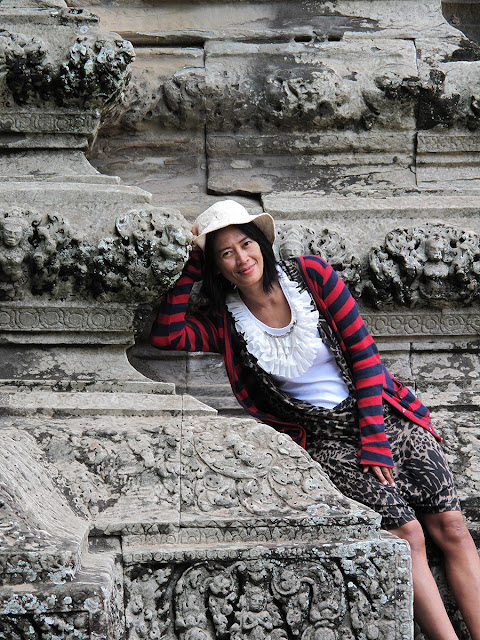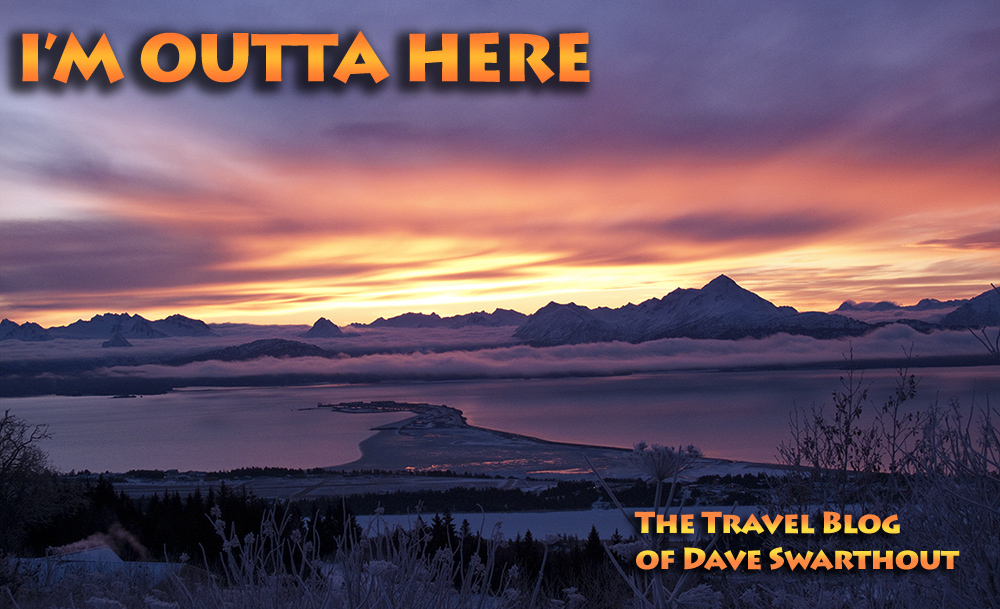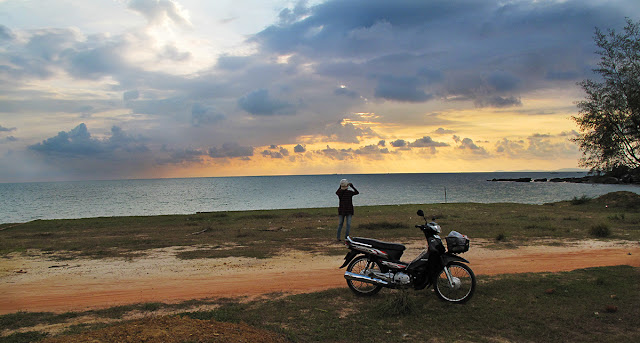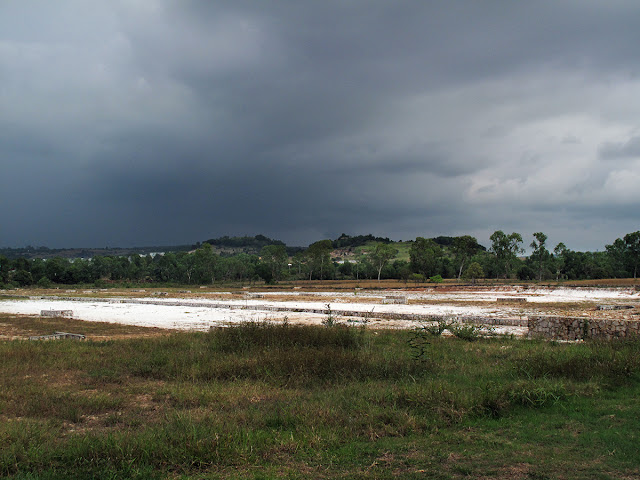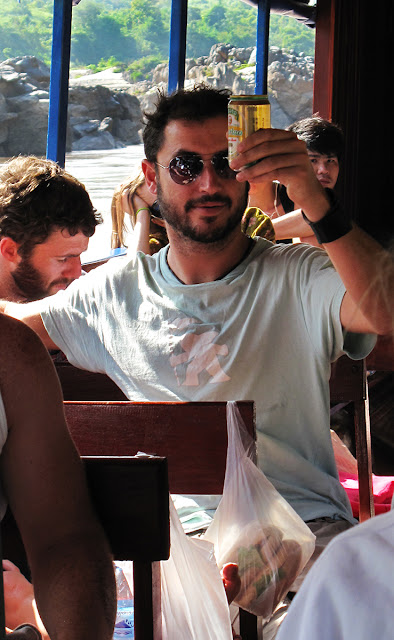December 1 - 4, 2010, Ban Pik Noi
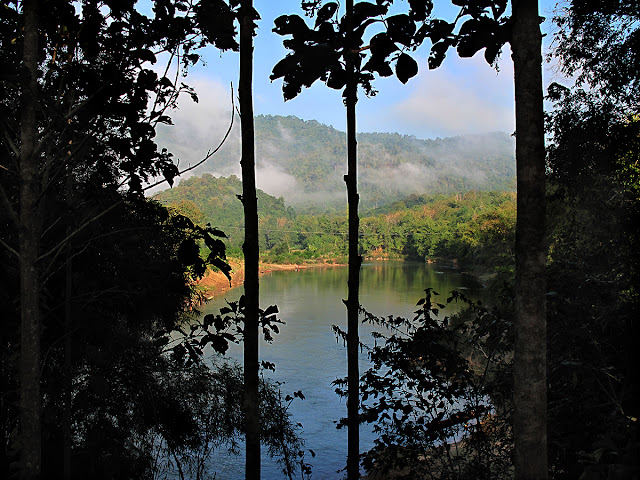 |
Morning mist and the Nam Khan river from Scott's deck
(N19.89203 E102.22663) |
We spent three days visiting Scott, an old Homer friend, at his rustic bungalow near this tiny Lao village (pop. 400) about 15 km east of Luang Prabang. Scott is an engineer and the type of guy that can do it all, from raising the new radio tower for KBBI Public Radio back in 1986 and relocating the station to its present quarters, to building his own home at 17 mile East Road, to speaking fluent Lao today. Lately he has built a simple but lovely dwelling on the east bank of the Nan Khan on the opposite side of the town proper. The Nam Khan is a medium sized tributary to the Mekong that joins it at Luang Prabang (see photo in the previous post) and along with the Mekong sort of defines the old city. With the help of some local workers he pulled a power cable across the river and hung it from posts he'd erected earlier. The power wires are suspended by cables whose tension was specified by calculations Scott made in advance. They applied the tension with a wire-rope come-along like the ones you can buy in Home Depot. However, there is no Home Depot, no Homer Electric Association in Laos nor are there any electrical contractors handy. If you want electricity, you make it happen on your own. From a stainless steel water tank mounted on a steel-pipe platform he built on the spot and erected with pulleys and ropes he derives running water that's been first pumped up to the tank from a well near the river -- he has a flush toilet and a hot shower -- more than I have in my present living situation in Homer.
 |
| Scott's home - Khoun is cooking breakfast at left - Scott is grinding coffee at right |
 |
| Scott grinding coffee |
As is typical for SE Asia, the house is made almost completely of concrete. It consists of a ceramic tiled concrete slab as the base with concrete block walls. There's a lot of hardwood trim inside though and the doors and shutter-style windows are also of hardwood.The roof is typical for SE Asia too -- fluted concrete tiles. Concrete is used for several reasons: it's relatively inexpensive, it's impervious to termites which attack any wood that is in or even close to the ground, and there are plenty of local craftsmen who can work with it. In fact, all the blocks were made on site from cement mixed with readily available river sand and gravel. This is especially handy as everything else must be floated across the river from town. Pretty damn impressive!
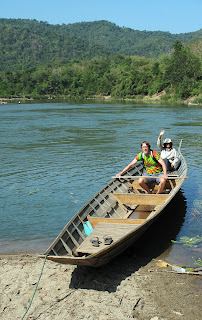
Scott has migrated to an amazing community. I met many of the local people, his neighbors, who by our standards are desperately poor, and found them to be hard working, fun loving and seemingly content with their situation. They were great folks to party with -- we had a dinner gathering that eventually developed into a beach BBQ party, and a picnic at Taat Sae, some particularly beautiful waterfalls about 10 km upriver from town. Everyone that attended was cool - we didn't have much to say to one another, obviously, because I speak no Lao or Thai, but Nut carried on conversations in Thai with them as did Scott and his partner Khoun.
During this time of the year everyone living along the river is collecting riverweed to make a local delicacy, kai-pan.The green weed is collected, pounded perhaps to tenderize it, chopped into smaller pieces and shaped into square sheets which are then sprinkled with sesame seeds and sometimes thin tomato slices and/or garlic. These sheets are then placed onto split bamboo drying racks and put out in the sun to dry.
 |
| After collecting the weed, the 2nd step in making kai-pan is pounding it with a stick. Everyone helps. |
 |
| Every home in Ban Pik Noi has these racks to sun dry the kai-pan sheets |
The sheets are then rolled up and stored for the rest of the year. One way to to eat the kai-pan is to plunge it into hot oil for a few seconds. It's a bit salty and tastes good -- everyone eats massive quantities of it. Scott recommended eating it with plenty of beer to quench your thirst. I bought into that completely.
The visit to Taat Sae waterfall was pretty cool too. Scott got one of his friends who owns a longboat with a motor and hired him to take up upstream to the falls for a picnic. We loaded the boat with our picnic stuff: beer and ice in a cooler, food for Khoun's special Lao salad, assorted snacks, a charcoal brazier (described below) and a fresh fish Nut had bought at the market the day before (it was alive when she got it). As we motored up the river, Khoun grilled the fish. Yep, while we were moving along he lit a fire and cooked the fish. Scott continually passed me glasses of Beer Lao with ice. I was nervous when turning around to grab the beer fearing I'd flip the very tippy-feeling longboat, which BTW was leaking water by the gallon. No worries, said Scott, all these boats leak like crazy. After a pleasant and uneventful trip up the river we reached the falls. We unloaded everything and hiked a short distance to the picnic area. It turns out that the falls are accessible from the road system so there were many other visitors, including some falangs, there enjoying the cool shade and the somewhat chilly water. I had half expected the falls to be similar to many of the other ones I'd seen in Thailand but these were quite a bit different. For one thing, there were elephants taking people for rides in the water. For another, minerals in the water have created some bizarre looking deposits. And the water is azure blue, presumably due to those same minerals.


 |
| Taat Sae Waterfalls |
We ate the fish and the Lao salad in the "picnic area" while some folks played in the water. There was one falang couple who had a baby with them, probably about 18-24 months old, who was an instant hit with all of the Lao girls, and with Nut. All Asians are fascinated by people with white skin, and this blonde toddler was not only very white but very cute and not at all shy about all the attention being showered on her. The girls photographed her, and one another holding her, constantly.
 |
| Lao girls and falang toddler |
 |
| Nut holding the falang toddler |
This fascination with whiteness is, to me, simply absurd. I know what it's about (poorer people work in the sun and are therefore darker) but the extent to which it dictates how Nut, for example, feels about her skin color is extreme. And she's not alone in that feeling. Far from it. Every skin product sold here includes whiteners and all the models, even Asian ones, have light skin. It's crazy.
Scott and Khoun met in Luang Prabang where Scott had a computer/Internet shop for a while when he first moved to Laos. Khoun is a native of Ban Pik Noi, speaks pretty good English, and is an amazing cook. Much of the day in any Asian home is spent eating and preparing food -- lucky is the visitor who gets a chance to spend time in a home where Khoun is cooking. We'd get up in the morning, have a couple of cups of strong Lao coffee while Khoun prepared a three-course breakfast. An example: rice, stir fried pork with mushrooms and ginger, stir fried veggies, sometimes an omelet made with local tomatoes and dill (Lao name is pakse). Delicious. Almost as soon as breakfast was over Khoun would start preparing lunch. And so on.

The coffee hereabouts is tasty and always brewed strong-- it's also very, very black. Scott thinks that's because they roast the beans in big pans or woks with a bit of sugar added. At any rate, you can add tons of evaporated milk to your cup and it simply refuses to lighten up. It reminds me a lot of the coffee roasted with chicory I loved so much in New Orleans.
 |
| Another great breakfast with Khoun and Scott |
Our last meal together was a masterpiece. The main course was Stuffed Deep-Fried Bamboo Shoots. Khoun served steamed squash and fried sticky-rice cakes with it and of course there was plenty of Beer Lao to wash it all down with. We drank Beer Lao with every meal except breakfast.
 |
| Khoun frying the bamboo shoots |
 |
| Bon appetit! |
If you'd like to make Stuffed Deep-Fried Bamboo Shoots for yourself here's how to proceed. The first part will be the hardest because you must find a thicket of bamboo somewhere. Got bamboo? Okay, now cut about 10 inches off the growing tips of as many young shoots as you think you'll need. For three people you'll want about 12-18 of them. Boil for an hour or so. (They can be stored in plastic bags for several months in this parboiled state by the way.) Now peel off the tough outer layers of each shoot and boil again for about another hour until the shoots are very tender. Drain well and allow to cool.
With a toothpick or other pointed object make many lengthwise cuts or slits along each shoot. You'll place the stuffing inside these slits. You've already prepared the stuffing, right? If not, here's the recipe: with a mortar and pestle grind together until smooth handfuls of lemon grass, garlic, and a small onion. Finely chop about a pound of lean pork loin (moo sap). Blend the chopped pork with the lemon grass mixture. Add a bunch of fresh pakse (dill) from the garden along with some nam pla (fish sauce) or soy sauce, some salt, and enough pork or chicken broth to make a moldable mixture. Stuff this mixture generously into the slits in each shoot.
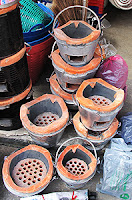
Get a steamer going because the pork must be cooked before deep frying. Everyone in SE Asia uses a wood or charcoal fired stove for a multitude of cooking chores. This is one of those chores. These stoves are made of concrete (see photo) and have a simple three point system that conveniently supports various pots, pans and woks. They're also semi-portable if a bit on the heavy side. Many of them are cast right inside of a galvanized bucket so they have a bail-type handle built in. You started your stove earlier, right? Okay, good. Place a few shoots at a time into a woven bamboo steamer basket over boiling water (I guess a stainless steel basket would work.) and steam them until the pork is fully cooked. Drain and pat dry.
Prepare a tempura type dipping mixture. Eggs, cornstarch, water, a bit of soy sauce and chicken concentrate for taste and some salt should do it. Dip each shoot into this mixture until completely covered, then drop into hot oil and with constant turning, fry until golden brown. Serve with deep fried black and white sticky rice crackers and Beer Lao over nam kang (ice cubes). Awesome! (You remembered to make the sticky rice didn't you? Oh hell, let's see.... )
December 9, 2010 Bangkok
It's been almost a week since we left Laos and I'm just finishing up this entry. I'm staying with Nut at her place and she has no Internet so I'm in a coffee shop working against the clock. Well, sort of.
Our trip to Lao was about rivers I reckon. The trip down the Mekong was mighty fine. And visiting Scott in his adopted home on the Nam Khan was awesome. Everything we saw and did revolved around river life. The weather in Lao was different too. Night time temperatures were in the low 60s -- one night it was 59 deg F -- and they sent Nut into a paroxysm of shivers every morning. She slept in all her clothes and under two blankets. While she enjoyed the good air and the sunny afternoons she soon got tired of being cold. I might've stayed for another week in Luang Prabang but we wanted to visit Cambodia before Christmas and I also have the Africa trip ahead. So we somewhat reluctantly made our way back to Bangkok. Two very long days on buses brought us first (the first leg was in Laos over very rough roads on a very old bus) to Nong Khai and then from there to Bangkok on quite a bit nicer Thai bus.
Tomorrow, we'll fly to Phnom Penh where we'll meet up with Albert. Last time I was there I chased bar girls and spent a lot of money on booze. This time I want to see Angkor Wat and also spend a few days in Sihanoukville. This visit promises to be quite a bit different. Stay tuned....
